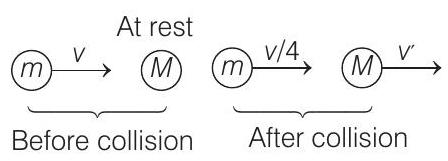Centre of Mass 3 Question 4
4. A body of mass
(2019 Main, 9 April I)
(a)
(b)
(c)
(d)
Show Answer
Answer:
Correct Answer: 4. (b)
Solution:
Key Idea For an elastic collision, coefficient of restitution (e), i.e. the ratio of relative velocity of separation after collision to the relative velocity of approach before collision is 1 .
Given, mass of small body,
Given situation is as shown

Using momentum conservation law for the given system, (Total momentum)
(Total momentum
Using value from Eq. (ii) into Eq. (i), we get
Key Idea Total linear momentum is conserved in all collisions, i.e. the initial momentum of the system is equal to final momentum of the system.
Given,
Let
Also,
Given situation of collinear collision is as shown below Before collision,

After collision,







